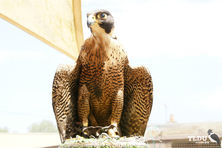
Shoppers Feedback:
Jan 17, 2017
Hello Ros,
I have now paid the invoice, but I would like to write to you just to say a big THANK YOU for getting me the Penguin!
The ChatterMate Penguin became a nice memory for me when I was in New Zealand, and I am so greatful to you for arranging so that I could have it! :-)
Thank you so much!!!!!!!!!!!
Regards,
Malin
Hi Ros,
Many thanks for your very kind email. I really appreciate your prompt reply!
I appreciate your advice regarding the decorations and customs. These are a gift for my daughter’s exchange student family so when she returns home on the weekend I will show her and see if she loves them as much as I do!
Thanks so very much again - I am truly grateful for your kind assistance.
Kind Regards
Bernadette
Ros,
Thanks again for the great customer service. It's a refreshing change!
Best regards,
Trevor
Hey Roz,
Thank you for your emails. Just loved my first order. The cute little Aussie bush critters are going to be used for an office Christmas decoration. My colleagues also liked them and talked about making an order to your site. I'll send you a photo when completed.
I'll be ordering more to send to my daughter's host family in America.
Fabulous service from you.
Kind regards,
Michelle
Thankyou. Order arrived today. One very happy grandson with his new beastly binoculars.
Regards,
Irene
- Home
- Wild Wonders
- Shop
- Aromas of Australia
- Australian Made
- Books
- Book Marks
- Christmas Decoration Sale
- Christmas Decorations
- Clocks
- Drink Holders
- Garden & Outdoor
- Gift Wrapping & Cards
- Home & Giftware
- Jewellery
- Keyrings
- New Products
- Pencils & Pen Holders
- Photo Frames
- Plush Toys
- Plush with Sound
- Sheepskin Rugs
- Stationery
- Stone Carvings
- Toys & Games
- Travel Goods
- Wedding
- Wild Figurines
- Wildlife Safety Products
- Wind Chimes
- Wine Charms
- View All Products
- Wildlife
- Australiana
- Explore
- Contact Us
Peregrine Falcon

Quick Facts
| Length: | 43 cm |
| Height: | - |
| Weight: | 765 grams |
| Colour: | - |
| Habitat: | Found in most habitats - rainforests to arid zones, most alit |
| Food: | Small and medium sized birds as well as rabbits and other day active mammals |
| Predators: | - |
| Status: | Rare in SA. Secure in all other states and territories in Australia |
Peregrine Falcons are large, powerfully built raptors (birds of prey), with a black hood, blue-black upperparts and creamy white chin, throat and underparts, which are finely barred from the breast to the tail. The long tapered wings have a straight trailing edge in flight and the tail is relatively short. The eye-ring is yellow, with the heavy bill also yellow, tipped black. Although widespread throughout the world, it is not a common species.
The Peregrine Falcon is often mistaken for the related Australian Hobby. However, this species has a different flight silhouette, with a curved trailing wing-edge, and lacks the full black hood.
The Peregrine Falcon is found across Australia, but is not common anywhere.
The Peregrine Falcon is found in most habitats, from rainforests to the arid zone, and at most altitudes, from the coast to alpine areas. It requires abundant prey and secure nest sites, and prefers coastal and inland cliffs or open woodlands near water, and may even be found nesting on high city buildings.
Largely resident, with young birds roaming at random until they are ready to breed.
The Peregrine Falcon feeds on small and medium-sized birds, as well as rabbits and other day-active mammals. It swoops down on its prey from above, catching or stunning it with its powerfully hooked talons, before grasping and carrying it off to a perch to pluck and eat it. It will pursue flying birds, being able to fly at speeds of up to 300 km/h, and it soars to a great height in search of prey. Pairs may hunt co-operatively, with one member, usually the male, scattering a flock of birds while the other swoops down to attack a particular individual. This co-operative behaviour is most often observed during the breeding season.
The Peregrine Falcon mates for life and pairs maintain a home range of about 20 km to 30 km square throughout the year. Rather than building a nest, it lays its eggs in recesses of cliff faces, tree hollows or in the large abandoned nests of other birds. The female incubates the eggs and is fed by the male on the nest. When the young have hatched, both parents hunt to provide food. Young Peregrine Falcons disperse widely, but often return to their original home area to breed when mature.
Pesticides have been found to thin the eggshells of Peregrine Falcons, decreasing their nesting success in some areas. However, although these birds are not common, they have successfully spread worldwide, and will sometimes nest on artificial structures such as the window ledges of high buildings.
Last Updated: Thursday 9th January, 2014
BirdLife Australia - www.birdlife.org.au
BUSH e-TELEGRAPH
Signup for our monthly newsletter the "e-Telegraph"
Quick Links
Home | The Beginning | About The Land Down Under | Wild Wonders | Advertise on Wild Wonders | Christmas Decoration Sale | Christmas Tree Decorations | Drink Holders | Plush with Sound | Stone Carvings | Wildlife Wine Charms | Freebies | Australian Wildlife | Help Our Wildlife | Australiana | Photo of the Month | Explore The Land Down Under | Contact Us | Legal Notices

